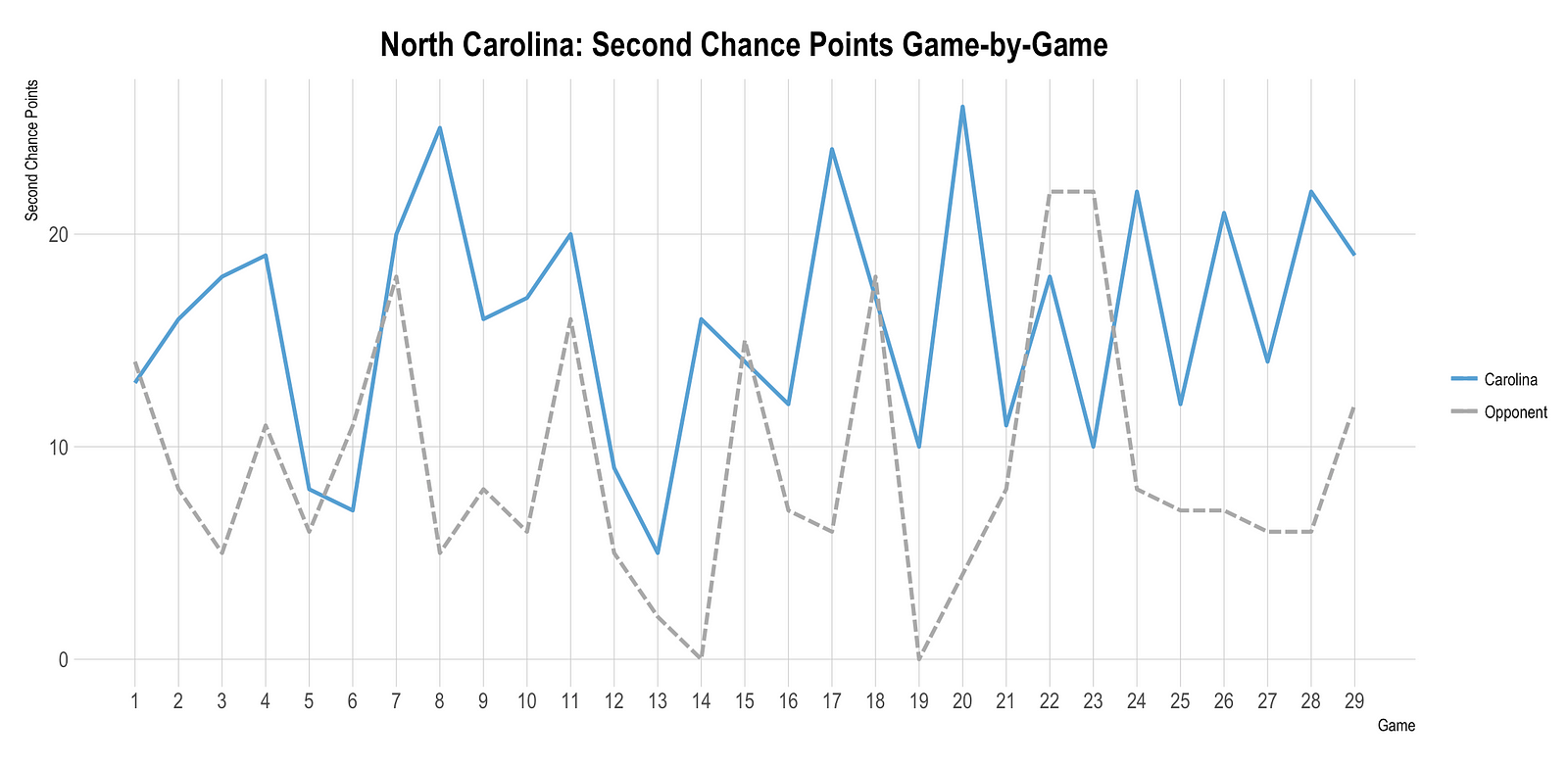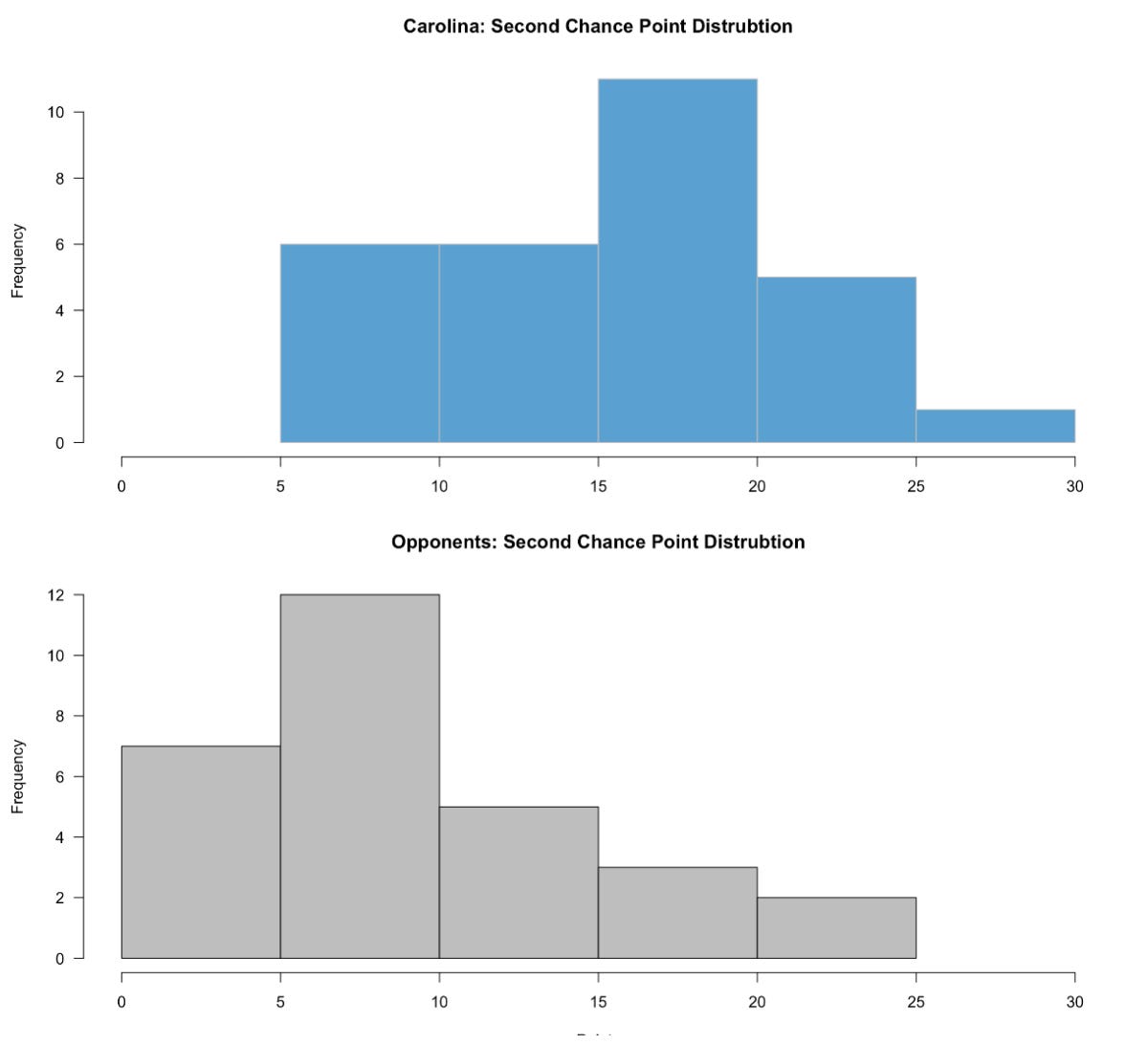Four Factor Friday: Second Chance Points
Goals change games. This is a old soccer cliche.
An obvious statement. Whether it’s true or not is up for debate, however, people have completed complex studies to confirm or deny it.
So what does this have to do with basketball?
Rebounds change games.
This is a belief of Roy Williams. It’s been a point of emphasis for all 15 of his Carolina teams. Whether the personnel is taller or smaller, Carolina is known for their ability to rebound.
“I believe the easiest way to be successful is to get more rebounds than you [opponents] get, Williams shared at ACC Media Day in the fall of 2017. You get the ball; I get the ball. You get the ball; I get the ball. So the only way to change that, if I get some offensive rebounds and don’t allow you to get any. So I think that’s the most important factor in the game. We’ve got to figure out a way to get some rebounds.”
So are the Tar Heels figuring out how to get some rebounds?
We can confirm. Despite playing a smaller lineup most of the time, the Tar Heels are snagging rebounds at an excellent rate.
As of February 22 with the regular season near its end, Carolina ranks second in the country in offensive rebounding percentage and 31st in the nation in defensive rebounding percentage.
What does that mean?
It means when the Tar Heels miss a shot, a player with argyle on his jersey is snagging a rebound almost 39 percent of the time. And when opponents miss a shot, Carolina gets the rebound about 75 percent of the time.
These numbers show up in second chance points.
More second chance points
— chris (@dadgumboxscores) February 22, 2018
Cam Johnson makes the jumper pic.twitter.com/0QdApaU9rz
When Carolina gets a rebound off a missed shot, the Tar Heels get another chance to score. And when opponents don’t retrieve a missed shot, that’s the only chance they get to score.
So what? Who cares?
The Tar Heels have scored more second chance points than their opponents 23 times in 29 games this season. Opponents have outscored Carolina six times in second chance points.
Carolina is 20-3 when scoring more second chance points than their opponent.
The Tar Heels are 2-4 when scoring fewer second chance points than their opponent.
Let’s go to some charts.
Chart Party
This line chart shows how second chance points have changed game-by-game throughout the season.

Notice the decline in second chance points for opponents during the six-game win streak. The Tar Heels have a +64 margin in second chance points during this six-game win streak.
These histograms show the distribution of second chance points for Carolina and its opponents this season.

Carolina has scored 15 or more second chance points in 17 games this season. Its opponents have only scored 15 or more second chance points six times.
And this table shows second chance points game-by-game.
A few notes:
- Carolina outscored Virginia 12-7 in second chance points, but also turned the ball over on 32 percent of its possessions
- Virginia Tech scored 11 second chance points to Carolina’s 9 second chance points, and Tar Heels turned it over on 19 percent of their possessions
- Carolina outscored Wofford 9-5 in second chance points only gathering 9 offensive rebounds off 35 missed shots
- Northern Iowa outscored Carolina 15-14 in second chance points in the season opener, and Carolina also made half its attempted shots
- Carolina beat Notre Dame by one-point on the road, and the Irish outscored the Tar Heels 18-17 in second chance points
So are second chance points the be all end all for success?
Not at all. There are equal or more important factors.
For example, it’s important to shoot the ball well. Everything looks better when it goes in the basket. And that goes for opponents too. The Tar Heels can’t prevent offensive rebounds if their opponents are making tons of shots.
Carolina needs to avoid turnovers. Because if Carolina turns the ball over, it means no one took a shot. And if no one took a shot, the Tar Heels can’t get the rebound.
The opposite is just as important. If opponents turn the ball over a lot, it gives Carolina more chances to shoot and get offensive rebounds.
The Tar Heels are also exposed at times in transition because Carolina sends three or so players to the offensive glass. This squad has given up 10 or more fast break points five times this season.
But this is what Carolina believes in. It’s a focus of the team, and it’s remarkable with a smaller lineup than usual that the Tar Heels rebound rate hasn’t missed a beat.
Carolina ranks 2nd in the country in offensive rebounding percentage (38.9) & 30th in the country in defensive rebounding percentage (24.6)
— chris (@dadgumboxscores) February 19, 2018
Roy Williams believes rebounding is important
Look at how Carolina's rebound rate has changed compared to D-I median over last 15 seasons pic.twitter.com/WmdvWZCRIL
Offensive rebounds and second chance points are staples of Roy Williams teams. The Tar Heels have ranked in the top-25 of offensive rebounding percentage 14 out of the last 15 seasons. The lone season outside the top-25 was in 2012-13, when Carolina ranked 77th in offensive rebound rate.
And en route to the 2017 National Championship, Carolina outscored its six opponents in the NCAA Tournament 116-68 in second chance points, including a 39-29 advantage in the Final Four with the two games being decided by a combined seven points.
Rebounds change games.